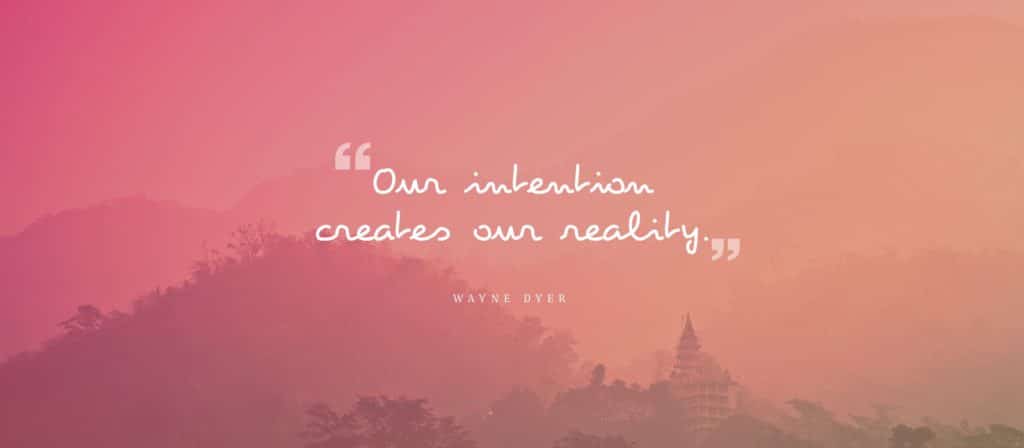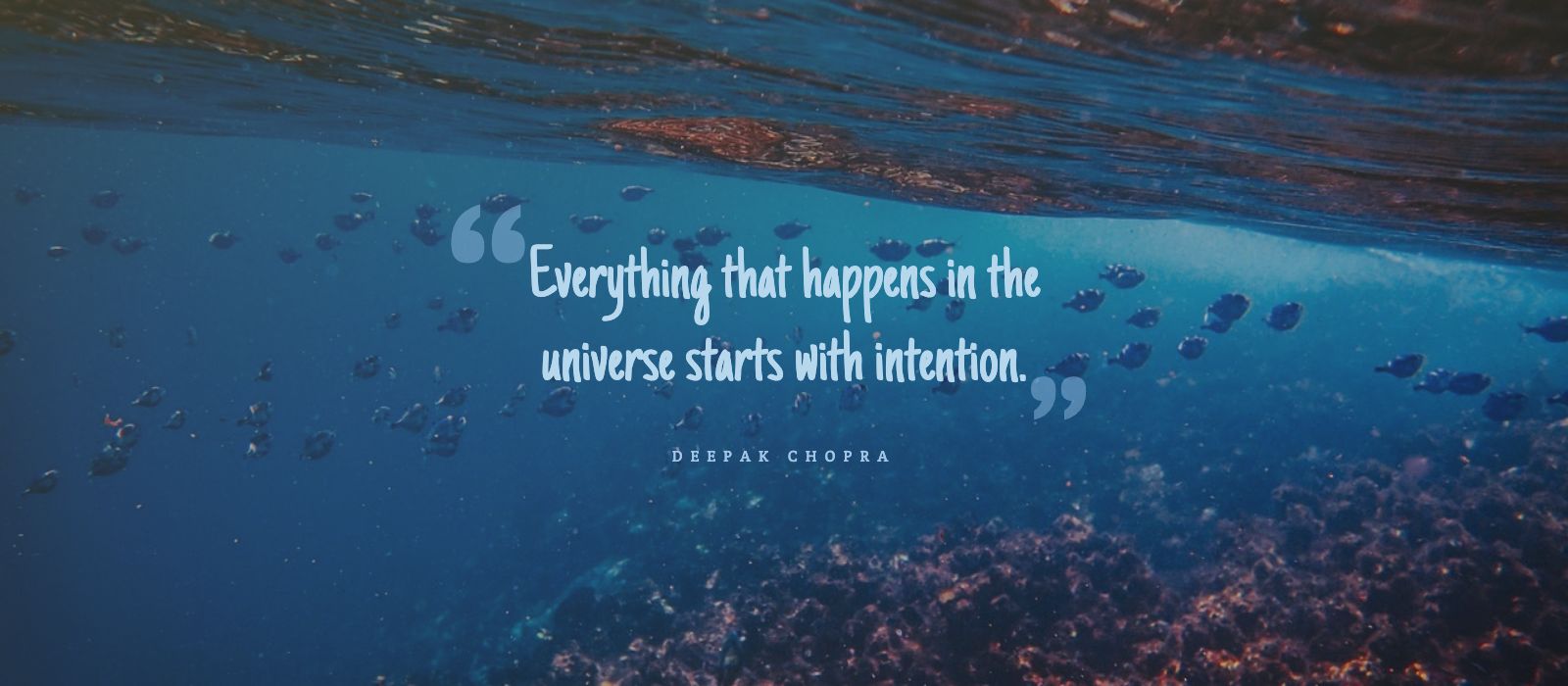Setting intention is one of the most important skills you can learn if you want to develop conscious control over the way you feel and the circumstances of your life.
When you take the time to set a clear intention for what you want to be, do, or feel, you become far more likely to have a positive outcome result from your experience. You can apply this skill to any challenge or any goal, from identifying specific daily tasks, to acting from a place of integrity, to enjoying long-lasting and fulfilling relationships or vital health.
In this post we’ll look at the power of intention, why it’s important, and how you can use it to create the life you desire.

How To Set Intentions for Your Day
At its core, setting an intention is simply the act of taking the time to decide what you want to do, before you do it.
When you set your intention for the day, you focus on your desired state, outlining what it is you want to do that day. You may wish to close your eyes and focus on your intention through a short meditation, or you can keep a soft gaze while you allow your intention to drift inward.
You may choose to focus on your progress towards a long-term goal, a specific series of tasks you have to do that day, or even a general feeling of how you want to move throughout the day.
I find that one of the most effective ways to set daily intentions is to separate your intention from your to-do list. If you focus too much on the details, it’s easier to get thrown off course when something unexpected happens to you.
Rather than list a specific set of actions you want to take, instead focus on the feeling you want those actions to instill. I like to combine this feeling with a general idea of what the task is, while leaving out any specifics.
For example, when writing this blog post, I didn’t set an intention to sit down and write a post that is 1,000 words long and includes 5 pictures, nor did I set an intention to sit and work for 2 hours. Instead, my intention was simply to communicate the topic as best I could, in the way that would help you, the reader.
This intention is broad, and includes the end goal, not the means, mechanisms, or methods of achieving it.
5 Guidelines for Setting Intentions
While the general act of setting an intention can be tailor made to fit any circumstance you choose, there are a few guidelines that will help you to make your intention setting process more effective, and help you to truly master the art of intention.

1. Focus on the Feeling
Firstly, intentions are best when they focus on the feeling-state you wish to achieve, rather than a specific physical objective.
Similar to the tip I mentioned above about keeping your intention general, this point takes it a step further. Ideally, you want to get to the place where your physical set of circumstances is less important to you than the way that you feel.
From this perspective, you understand that your goals are merely symbols for your true desires, and what you really want is to feel the emotion, the state of being, that the goal represents.
If you can identify this feeling-state anf focus your intention on it, rather than on worldly events, then you can achieve your intention immediately, and maintain it more consistently throughout the day. This helps you to live more fully from your place of intention, rather than allow the world to dictate your mood based on events that happen.
Discover new ways to increase your happiness.
2. Internalize Your Intention
The second guideline is to do your best to internalize your intention. This is why you may choose to enter a meditative or pseudo-meditative state when establishing what your intention is for the day.
The more you can draw your awareness inward, the more easily you can internalize the idea and draw upon powerful energy and intuitive guidance from your subconscious.
This is a form of programming your mind to achieve whatever it is you choose, before it actually happens in the physical world. You can train your mind to be, do, or have your goal first, so you can more fully enjoy the pursuit of it.
Learn more about how to follow your intuition.
3. Begin with the End in Mind
In order to use intention effectively, you must also begin with the end in mind. This is another way of saying that you should keep your intention open to more general, perhaps longer term aims, rather than set an expectation of one specific thing you want to happen that day.
As you do, you keep yourself more open to allowing positive energy into your day, in a way that balances your current desire to feel good with the longer trajectory you set for yourself.
Read more about visualization techniques for success.
4. Clarify Your Vision
As you are beginning with the end in mind, you should also take the time to clarify what it is that you want.
Clear intentions are more powerful than vague ideas. As you clarify your desire in your mind’s eye, you focus energy like a laser, which helps to create favorable conditions in the world around you. You become more attuned to the positive aspects that are already before you, see additional opportunities, and acknowledge more readily the progress you are making.
Note that clarifying your vision is different than identifying specific actions you want to take or events you expect to happen. In other words, you are not clarifying how your intention will arise for you, you are clarifying what it is you want to feel.
5. Set Your Intention Frequently Throughout The Day
Lastly, remember to set your intention frequently throughout the day. This is one of the most often overlooked elements of intention: the power of intention comes when you stick with it.
While setting your intention each morning before you begin the day is, by itself, incredibly powerful, you can make the process even more effective by taking a few moments to re-center and remember that intention as you move throughout the day.
This could take anywhere from a few seconds to a few minutes, as you simply take a moment to breathe, draw your attention inward, and remember what it is you actually want to do, and how you want to feel.
Re-centering on your intention throughout the day can also be really helpful when you are switching between different types of tasks. Your intention when you begin the day at work, for example, is different than the intention you have when you are driving home to see your family. Abraham Hicks calls this process segment intending, and outlines it as one of the best ways to stay in alignment with your goals.
Explore more Abraham Hicks Processes to help you raise your energy and maintain a state of alignment.
Example: 3 Daily Intentions for Gratitude and Success

There are many, many different types of intention, and the most important point is that you always choose something that works for you. However, I wanted to give an example of a three-step intention process that I find very effective.
This process combines gratitude and appreciation with intention.
The phrases are:
- Thank you for helping me…
- Thank you for expanding me…
- Thank you for inspiring me…
To do this process, fill in the end of each sentence. I like to use the first sentence for something I have recently achieved or improved and feel grateful for; the second sentence I use for something I am currently progressing through; the third I use for something towards which I aspire.
Then, read these sentences to yourself, using the positive affirmation exercise I describe in this video.
Working with these phrases can be incredibly powerful, and I hope you give it a try.




